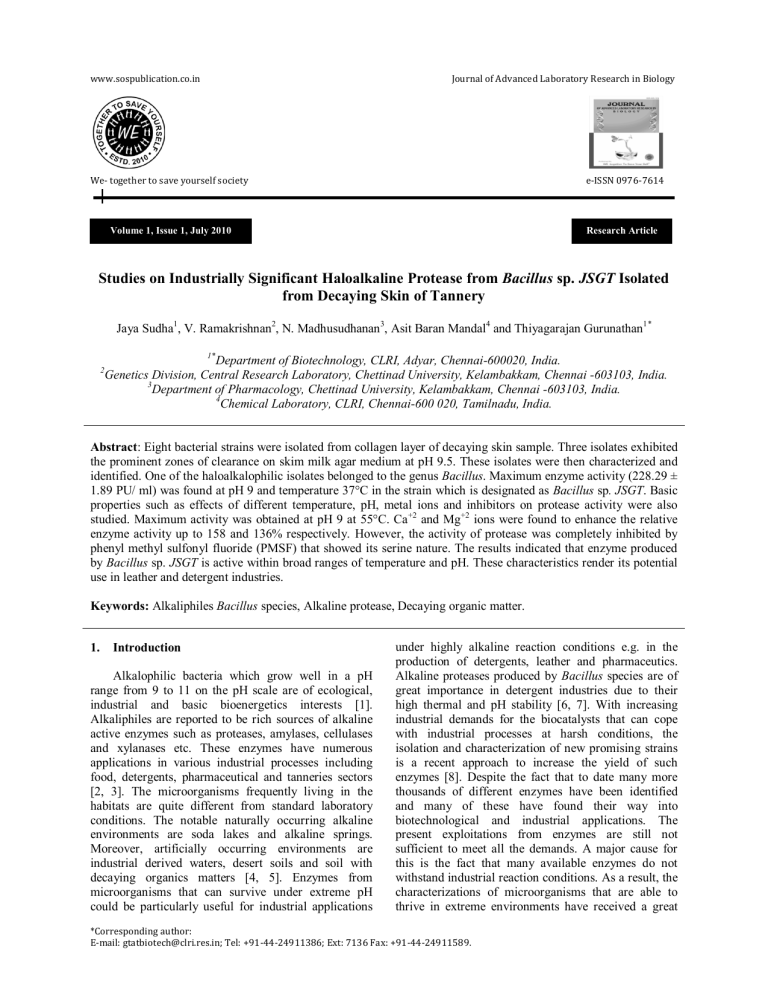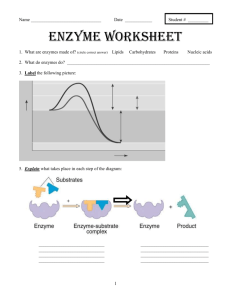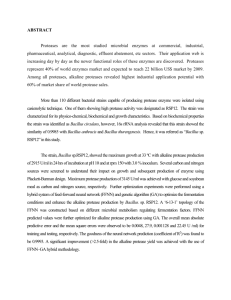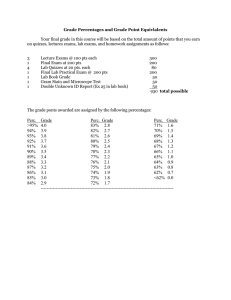Studies on Industrially Significant Haloalkaline Protease from Bacillus sp. JSGT Isolated from Decaying Skin of Tannery
advertisement

www.sospublication.co.in Journal of Advanced Laboratory Research in Biology We- together to save yourself society e-ISSN 0976-7614 Volume 1, Issue 1, July 2010 Research Article Studies on Industrially Significant Haloalkaline Protease from Bacillus sp. JSGT Isolated from Decaying Skin of Tannery Jaya Sudha1, V. Ramakrishnan2, N. Madhusudhanan3, Asit Baran Mandal4 and Thiyagarajan Gurunathan1* 1* 2 Department of Biotechnology, CLRI, Adyar, Chennai-600020, India. Genetics Division, Central Research Laboratory, Chettinad University, Kelambakkam, Chennai -603103, India. 3 Department of Pharmacology, Chettinad University, Kelambakkam, Chennai -603103, India. 4 Chemical Laboratory, CLRI, Chennai-600 020, Tamilnadu, India. Abstract: Eight bacterial strains were isolated from collagen layer of decaying skin sample. Three isolates exhibited the prominent zones of clearance on skim milk agar medium at pH 9.5. These isolates were then characterized and identified. One of the haloalkalophilic isolates belonged to the genus Bacillus. Maximum enzyme activity (228.29 ± 1.89 PU/ ml) was found at pH 9 and temperature 37°C in the strain which is designated as Bacillus sp. JSGT. Basic properties such as effects of different temperature, pH, metal ions and inhibitors on protease activity were also studied. Maximum activity was obtained at pH 9 at 55°C. Ca+2 and Mg+2 ions were found to enhance the relative enzyme activity up to 158 and 136% respectively. However, the activity of protease was completely inhibited by phenyl methyl sulfonyl fluoride (PMSF) that showed its serine nature. The results indicated that enzyme produced by Bacillus sp. JSGT is active within broad ranges of temperature and pH. These characteristics render its potential use in leather and detergent industries. Keywords: Alkaliphiles Bacillus species, Alkaline protease, Decaying organic matter. 1. Introduction Alkalophilic bacteria which grow well in a pH range from 9 to 11 on the pH scale are of ecological, industrial and basic bioenergetics interests [1]. Alkaliphiles are reported to be rich sources of alkaline active enzymes such as proteases, amylases, cellulases and xylanases etc. These enzymes have numerous applications in various industrial processes including food, detergents, pharmaceutical and tanneries sectors [2, 3]. The microorganisms frequently living in the habitats are quite different from standard laboratory conditions. The notable naturally occurring alkaline environments are soda lakes and alkaline springs. Moreover, artificially occurring environments are industrial derived waters, desert soils and soil with decaying organics matters [4, 5]. Enzymes from microorganisms that can survive under extreme pH could be particularly useful for industrial applications under highly alkaline reaction conditions e.g. in the production of detergents, leather and pharmaceutics. Alkaline proteases produced by Bacillus species are of great importance in detergent industries due to their high thermal and pH stability [6, 7]. With increasing industrial demands for the biocatalysts that can cope with industrial processes at harsh conditions, the isolation and characterization of new promising strains is a recent approach to increase the yield of such enzymes [8]. Despite the fact that to date many more thousands of different enzymes have been identified and many of these have found their way into biotechnological and industrial applications. The present exploitations from enzymes are still not sufficient to meet all the demands. A major cause for this is the fact that many available enzymes do not withstand industrial reaction conditions. As a result, the characterizations of microorganisms that are able to thrive in extreme environments have received a great *Corresponding author: E-mail: gtatbiotech@clri.res.in; Tel: +91-44-24911386; Ext: 7136 Fax: +91-44-24911589. Studies on Industrially Significant Haloalkaline Protease from Bacillus sp. Jsgt deal of attention. Microorganisms also account for a two-thirds share of commercial protease’s production in the world [9]. Being the most important sources for enzyme production, the selection of suitable microorganism plays a key role in a high yield of desirable enzyme. The present study reports isolation, characterization and identification of proteolytic bacteria isolated from decaying skin. A maximum producer of proteolytic enzyme has been studied in detail and essential properties of the enzyme are also described for its industrial significance. 2. Materials and Methods 2.1 Isolation of alkaliphiles The sample was collected from the upper collagen layer of skin which is obtained from the tannery of Central Leather Research Institute (CLRI) Chennai, Tamilnadu. About 1.0 g of skin sample was transferred to 99.0 ml sterilized normal saline in 250 ml conical flask and agitated (100 rpm) at 37°C for 1h on a shaker (Scigeneics, India). The skin suspension was then diluted in serial up to 10-7 dilutions. One ml of each dilution was poured into Petri plates containing nutrient agar medium of pH 9. The inoculated plates were then incubated at 37°C for 24 hours. 2.2 Screening of bacterial alkaliphiles Individual bacterial colonies were screened for production of proteolytic enzyme on skim milk agar medium containing skim milk 1.0%, peptone 0.5%, sodium chloride 5% and agar 2.5%. The pH of the medium was adjusted at 9 with 1 N HCl/1N NaOH before sterilization at 120°C for 15 minutes. The inoculated plates were then incubated at 37°C for 48 h and observed for zones of clearance which indicate proteolytic activities. 2.3 Identification of the proteolytic isolates The bacterial isolates with prominent zones of clearance were processed for the determination of morphology, gram characteristics, motility, citrate utilization, oxidase, urease, gelatin liquefaction, catalase, VP indole tests, acid production from DGlucose, D-Arabinose, D- Lactose, D-Mannitol, DGalactose and D-Maltose. The isolates were also grown at different temperatures, pH and NaCl concentrations. These isolates were then identified in accordance with the methods recommended in Bergey’s Manual of Determinative Bacteriology [10] and Diagnostic Microbiology [11]. The identified strains were maintained on nutrient agar slants having pH 9 at 4°C. 2.4 Preparation of crude enzyme extracts Fifty ml of nutrient broth having pH 9 was inoculated with each isolate and incubated at 37°C for 48 h in a shaker at 130 rpm. The inoculated broth was then centrifuged at 10000 x g for 10 minutes at 4°C. J. Adv. Lab. Res. Biol. Thiyagarajan et al The supernatant was used to determine the protease activity. 2.5 Determination of proteolytic activity Proteases activity was determined by a slightly modified method of Anson-Hagihara [12]. The reaction mixture containing 1 ml of 1.0% casein solution in 0.05 M Glycine-NaOH buffer having pH 10 and 1 ml of a given enzyme solution were incubated at 37°C for 20 minutes and the reaction was then stopped with 3 ml of 10% trichloroacetic acid (TCA). The absorbance of the liberated tyrosine in the filtrate was measured at 280 nm. One proteolytic unit was defined as the amount of the enzyme that released 1μg of tyrosine under the assay conditions. 2.6 Determination of biomass The biomass (dry weight) of the bacterial isolates was determined after centrifugation of the fermented broth at 10000 x g for 10 minutes at 4°C. The residual material in the form of pellet was dried at 105°C till consistent weight was achieved. 2.7 Total protein assay Total protein contents of the enzyme solution were measured according to the method described by Lowry [13]; using bovine serum albumin (BSA) as a standard. 2.8 Partial Characterization of Protease 2.8.1 Effect of pH on protease activity The effect of pH on alkaline protease from Bacillus sp. JSGT was determined by assaying the enzyme activity at different pH values ranging from 6.0 to 12.0, using the following buffer systems: phosphate (pH 6-7) tris–HCl (pH 8-9) and glycine-NaOH (pH 1012). The concentration of each buffer was 0.05 M. 2.8.2 Effect of temperature on protease activity The effect of temperature on alkaline protease activity was determined by incubating the reaction mixture (pH 9) for 20 minutes at different temperature ranging from 30°C to 65°C. The activity of the protease was then measured as per the assay procedure. 2.8.3 Effect of inhibitors and metal ions on protease activity The effect of various inhibitors such as phenyl methyl sulphonyl fluoride (PMSF), di-isopropyl fluorophosphate (DFP), cysteine inhibitors pchloromercuric benzoate (pCMB), ethylenediamine tetraacetic acid (EDTA) and metal ions (Zn+2, Mg+2, Na+2, Ca+2, Al+3, Cu+2, and Hg+2) on protease activity were investigated to further characterize the enzyme. The crude alkaline protease was pre-incubated with the above-mentioned chemicals for 20 minutes at 37°C; afterward, the residual activity (%) was measured by standard protease assay. The final concentration of each 47 Studies on Industrially Significant Haloalkaline Protease from Bacillus sp. Jsgt inhibitor and metal ions was 5mM at the time of preincubation. 3. Results and Discussion In this study 8 bacterial strains were isolated from decaying skin sample suspension processed on nutrient agar medium. The objective of the study was to isolate and identify haloalkalophilic microorganism having the potential to secrete enzyme of extracellular proteolytic activity. Out of 8 isolates, three exhibited vibrant zones of clearance on 1.0 % skim milk agar medium at pH 9 as shown by Bacillus sp. JSGT (Figure 1). These isolates were identified and were represented by the genus Bacillus, Pseudomonas and Aspergillus as shown in Table 1. This shows that Bacillus sp. is ubiquitous and endures the extreme conditions of saline. Thiyagarajan et al were tested under extreme Saline and alkaline conditions to find out the best haloalkaline protease producer. It was found that Bacillus sp. JSGT produced maximum proteolytic enzyme (228.29 ± 1.89 PU/ml) followed by Pseudomonas Sp. and Aspergillus Sp. with the enzymatic activity of 164.37 ± 1.77 PU/ml and 131.45 ± 1.34 PU/ml respectively (Table 2). The effect of temperature on protease activity was shown in Figure 2. An initial increase in temperature up to 55°C increased the rate of enzyme’s catalyzed reaction which resulted in increase of proteolytic activity. However, beyond the temperature 55°C, the enzyme denatured rapidly and thus loosed its activity. Maximum proteolytic activity of Bacillus strains HR-08 and KR-8102 isolated from the soil of west and north parts of Iran have been recorded at 65°C and 50°C respectively [19]. These findings show that strains isolated from different habitats express extra-cellular products of varying characteristics. Similarly, pH also plays an important role in the activity of enzyme. The enzyme produced by Bacillus sp. JSGT was found to yield maximum activity at pH 9 (Figure 3). The earlier findings describe that maximum enzyme activity at a temperature range of 60-65°C at pH 11 by Bacillus clausii 1-52 (20). Fig: 1. Bacillus sp. JSGT Showing protease production by zone of hydrolysis. In many reports, the isolation of diverse species of Bacillus was obtained from natural soils. For instance, 42 different species of genus Bacillus were identified from grassland soil samples of which five species were recognized as novel species of Bacillus and designated as B. novalis sp. nov., B. vireti sp. nov., B. soli sp. nov., B. bataveinsis sp. nov., and B. drentensis sp. nov. [14]. In another study, it was observed that 27 bacteria out of 40 isolates from soil samples belonged to the genus Bacillus [15]. It is known that proteolytic bacteria are more abundant in topsoil as compared to a subsoil sample [16]. All these findings indicate that Bacillus species are widely distributed in soil and other natural environments characterized by a wide range of different physiological conditions. Most of the commercially important alkaline proteases are derived from Bacillus species. In fact, these bacteria are known for their abilities to secrete large amounts of alkaline proteases having a significant proteolytic activity and stability at considerably high pH, temperatures and saline environments [17, 18]. In the present study, the proteolytic activities of the isolated Bacillus species J. Adv. Lab. Res. Biol. Fig. 2. Effect of different temperature on protease activity from Bacillus sp. JSGT. Fig. 3. Effect of pH on protease activity from Bacillus sp. JSGT. Bars represent S.D. 48 Studies on Industrially Significant Haloalkaline Protease from Bacillus sp. Jsgt Inhibition studies primarily give insight about the nature of the enzymes, its cofactor requirements and the active center of the enzyme [21]. Effect of different inhibitors at 5 mM concentration was studied. It appeared that PMSF inhibited protease completely, while DFP exhibited 94 % inhibition. PMSF is a serine protease inhibitor which results in complete loss of the enzyme activity after inhibition [22, 23]. The protease produced by Bacillus sp. JSGT was completely inhibited by PMSF which indicates that it is a serine protease. Other inhibitors slightly inhibited the protease activity. Effects of some metal ions on the protease activity were also studied and observed that Ca+2 and Mg+2 ions increase the relative enzyme activity up to 158 and 136 % respectively (Table 3). Similarly, Mn+2, Thiyagarajan et al Ca+2 and Mg+2 ions have been described to increase the relative protease activity produced by Bacillus megaterium isolated from thai fish sauce [24]. These cations also have been reported to increase the activity and thermostability of alkaline proteases of Bacillus [25]. It has been suggested that concerned metal ions apparently protect the enzyme against thermal denaturation and play a vital role in maintaining the active conformation of the enzymes at higher salt concentration, pH and temperatures [26]. Identification of proper ions and their suitable concentrations for rendering halotolerant and thermostability to the enzymes are very important for their applications at commercial levels. Table 1. Phenotypic and biochemical comparison of proteolytic species isolated from decaying skin sample. Tests Morphology Motility Gram staining Growth at °C 5 30 40 50 55 Growth at pH 8 9 10 11 12 Growth in NaCl 2% 5% 7% 10 % 15 % Glucose Arabinose Maltose Growth in Galactose Mannitol Carbohydrates Xylose Sucrose Lactose Hydrolysis of Casein Gelatin Citrate utilization Urease Catalase Indol Biochemical tests VP test Oxidase Growth on MacCkony agar + (Positive); - (Negative); W (Weak Growth) Bacillus Rods + + + + + W + + + + W + + + + + + + + + + + + + + + + Bacterial Isolates Pseudomonas Aspergillus Rods Rods + + + + + W W W + + + + + + + + + + W W + + + + + + + + + + + + + + + + + + + + + + + + Table 2. Protease productions by different haloalkaliphilic species incubated at 37°C for 48 hrs in nutrient broth medium at pH 9. Strains Dry cell mass ( g/L) ± S.D.* Total Protein (g/L) ± S.D.* Aspergillus sp. JSGT-2 0.56 ± 0.04 1.11 ± 0.06 Pseudomonas sp. JSGT-1 0.55 ± 0.03 1.22 ± 0.05 Bacillus sp. JSGT 0.95 ± 0.02 1.22 ± 0.01 *Each value corresponds to mean of three replicates ± standard deviation J. Adv. Lab. Res. Biol. Enzymes Activity (PU/ml) ± S.D.* 131.45 ± 1.34 164.37 ± 1.7 228.29 ± 1.89 49 Studies on Industrially Significant Haloalkaline Protease from Bacillus sp. Jsgt Table 3. Effect of inhibitors and activator on the relative activity protease produced by Bacillus sp JSGT. Inhibitors/ Activator* Relative Activity (%) Control 100 PMSF 0 DFP 12 PCMB 79 EDTA 69 +2 Zn (ZnCl2) 58 +2 Mg (MgCl2) 136 +2 Na (NaCl2) 88 +2 Ca (CaCl2) 158 +3 Al (AlCl3) 91 +2 Cu (CuCl2) 49 +2 Hg (HgCl2) 33 *PMSF = Phenylmethyl sulphonyl fluoride; DFP= di-Isopropyl fluorophosphate; pCMB= p- Chloromercuric benzoate; EDTA= Ethylene diamine tetra acetic acid. The concentration of all inhibitors and metal ions was 5mM. 4. Conclusion The aim of this research work was to isolate species from the habitat of salt putrefied skin and to investigate the capability of the strains to secrete proteolytic enzymes under haloalkaline condition (pH 9). Bacillus sp. JSGT produced maximum yield of alkaline protease (228.29 ± 1.89PU/ml) and it was selected as a potent strain for further studies. The optimum temperature and pH were determined as 55°C and 9 respectively for the production of haloalkaline protease by Bacillus sp. JSGT. Effects of metal ions and inhibitors indicated that the haloalkaline protease belongs to the family of serine proteases. These properties indicate the potential use of the enzyme in detergent and leather industries. Acknowledgments I wish to express my sincere thanks to Dr. C. Rose, Head, Department of Biotechnology, CLRI, for his inspiring and constant encouragement throughout this work. References [1]. Horikoshi, K. (1999). Alkaliphiles: Some applications of their products for biotechnology. Microbiol. Mol. Biol. Rev., 63 (4): 735-750. [2]. Dermirijan, D.C., Moris, V.F. & Cassidy, C.S. (2001). Enzymes from extremophilles. Curr. Opin. Chem. Biol., 5 (2): 144-151. [3]. Nilegaonkar, S.S., Kanekar, P.P., Sarnaik, S.S. & Kelkar, A.S. (2002). Production, isolation and characterization of extracellular protease of an alkaliphillic strain of Arthrobacter ramosus, MCMB-351 isolated from the alkaline lake of Lonar, India. World J. Microbiol. Biotechnol., 18 (8): 785-789. J. Adv. Lab. Res. Biol. Thiyagarajan et al [4]. Kanekar, P.P., Nilegaonkar, S.S., Sarnaik, S.S. & Kelkar, A.S. (2002). Optimization of proteases activity of alkaliphilic bacteria isolated from an alkaline lake in India. Biores. Technol., 85 (1): 87-93. [5]. Zeynep, U. & Metin, D. (2002). Alkaliphilic microorganisms and habitats. Turkish J. Biol., 26 (3): 181-191. [6]. Denizci, A.A., Kazan, D., Abeln, E.C.A. & Erarslan, A. (2004). Newly isolated Bacillus clausii GMBAE 42: an alkaline protease producer capable to grow under highly alkaline conditions. J. Appl. Microbiol., 96 (2): 320-327. [7]. Naidu, K.S.B. & Devi, K.L. (2005). Optimization of thermostable alkaline proteases production from species of Bacillus using rice bran. African J. Biotechnol., 4 (7): 724-726. [8]. Gupta, R., Beg, Q.K. & Lorenz, L. (2002). Bacterial alkaline proteases: molecular approaches and industrial applications. Appl. Microbiol. Biotechnol., 59 (1): 15-32. [9]. Kumar, C.G. & Takagi, H. (1999). Microbial alkaline proteases: from a bio-industrial point of view. Biotechnol. Adv., 17 (7): 561-594. [10]. Holt, J.G., Krieg, N.R., Sneath, P.H.A., Stately, J.T. & William, S.T. (1994). Bergey’s Manual of Determinative Bacteriology, 9th Ed., Williams and Wilkins, Baltimore, Maryland, USA, pp. 559. [11]. Betty, A.F., Daniel, F.S. & Alice, S.W. (2002). Bacillus and similar organisms. In: Diagnostic Microbiology, 11th Edition, Published by Mosby Inc. 11830 West line Industrial Drive, St. Louis, Missouri 63146, USA, pp 317-324. [12]. Hagihara, B. (1958). The Enzymes. Vol., 4., Academic Press, Inc., New York. [13]. Lowry, O.H., Roserbrough, N.J., Farr, A.L. & Randall, R. (1951). Protein measurement with Folin Phenol Reagent. J. Biol. Chem., 193 (1): 265-275. [14]. Jeroen, H., Bram, V., Niall, A.L., Balcaen, A., Marina, R.D., Andreas, S. & Paul, D.V. (2004). Bacillus novalis sp. nov., Bacillus vireti sp. nov., Bacillus soli sp. nov., Bacillus bataveinsis sp. nov, and Bacillus drentensis sp. nov., from the Drentse A grasslands. Int. Syst. Evol. Microbiol., 54 (1): 47-57. [15]. Belma, A., Zehra, N.Y. & Yavuz, B. (2002). Determination of PHB growth quantities of certain Bacillus species isolated from soil. Turkish Elect. J. Biotechnol. Special issue: 24-30. [16]. Bach, H.J. & Munch, J.C. (2000). Identification of bacterial sources of soil peptidases. Biol. Fertil. Soils, 34 (3-4): 219-224. [17]. Kumar, C.G., Malik, R.K. & Tiwari, M.P. (1998). Novel enzyme based detergents: an Indian perspective. Curr. Sci., 75 (12): 1312-1318. [18]. Pastor, M.D., Lorda, G.S. & Balatti, A. (2001). Proteases production using Bacillus subtilis- 3411 50 Studies on Industrially Significant Haloalkaline Protease from Bacillus sp. Jsgt [19]. [20]. [21]. [22]. and amaranth seed meal medium at different aeration rate. Brazilian J. Microbiol., 32 (1): 6-9. Moradian, F., Khajeh, K., Naderi-Manesh, H., Ahmadvand, R., Sajedi, R.H. & Sadeghizadeh, M. (2006). Thiol-dependent serine alkaline proteases from Bacillus sp. HR-08 and KR-8102: isolation, production and characterization. Appl. Biochem. Biotechnol., 134 (1): 77-87. Joo, H.S., Kumar, C.G., Park, G.C., Palk, S.R. & Chang, C.S. (2003). Oxidant and SDS-stable alkaline protease from Bacillus clausii 1- 52: production and some properties. J. Appl. Microbiol., 95 (2): 267- 272. Horton, H.H., Moran, L.A., Raymond, S.O., Rawn, J.D. & Scrimgeour, K.G. (1996). Properties of enzymes. In: Principles of Biochemistry. 2nd edition, printed by prenticehall International, Inc. USA, p.119-146. Jeong, Y.H., Wei, C.I., Preston, J.F. & Marshall, M.R. (2000). Purification and characterization of proteases from hepatopancreas of crawfish J. Adv. Lab. Res. Biol. [23]. [24]. [25]. [26]. Thiyagarajan et al (Procambarus clarkii). J. Food Biochem., 24 (4): 311- 332. Adinarayana, K., Ellaiah, P. & Prasad, D.S. (2003). Purification and characterization of thermostable serine alkaline protease from a newly isolated Bacillus subtilis PE-11. Pharma. Sci. Technol., 4 (4): 1-9. Siriporn, Y., Alissara, R. & Masaki, Y. (2006). Purification and characterization of alkaline protease from Bacillus megetarium isolated from thai fish Sauce fermentation process. Sci. Asia, 32: 377-388. Johnvesly, B. & Naik, G.R. (2001). Studies of production of thermostable alkaline protease from thermophilic and alkaliphilic Bacillus sp. JB-99 in a chemical defined medium. Process Biochem., 37 (2): 139-144. Donaghy, J.A. & Mckay, A.M. (1993). Production and properties of alkaline proteases by Aureobasidium pullulans. J. Appl. Bacteriol., 74 (6): 662 – 666. 51



